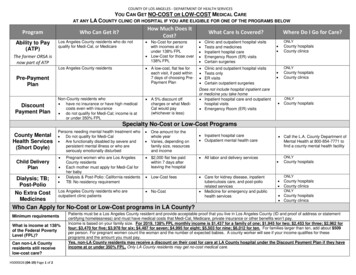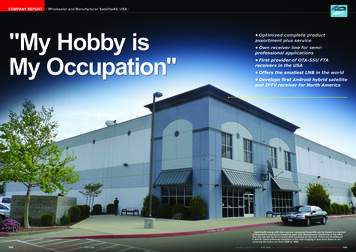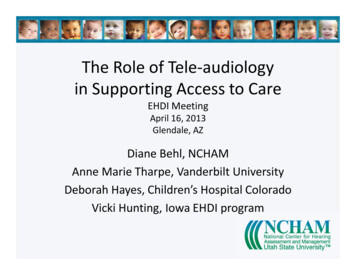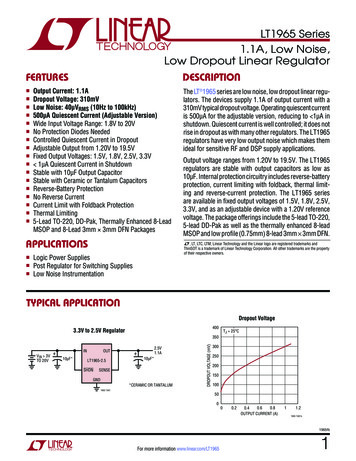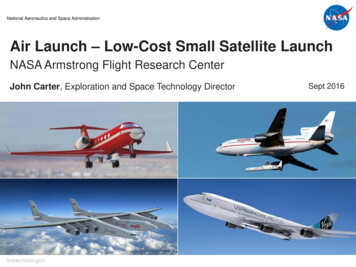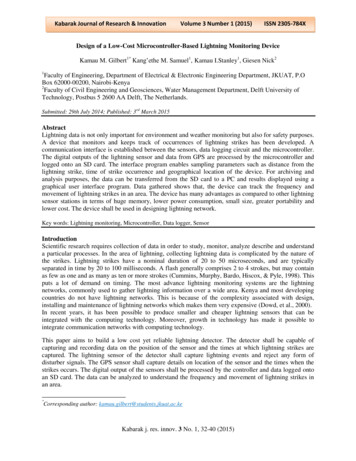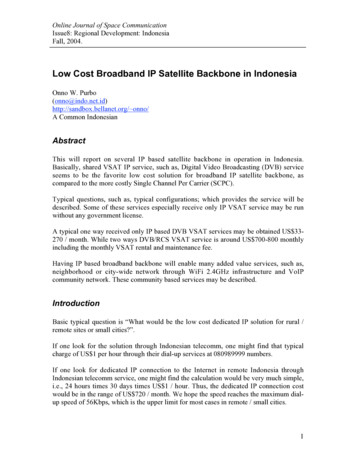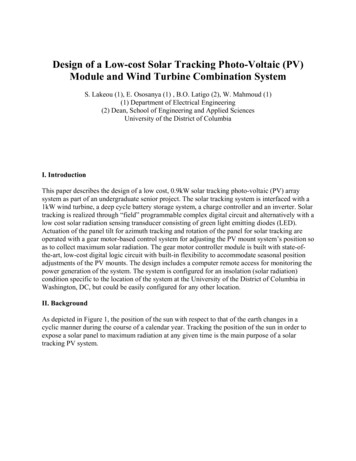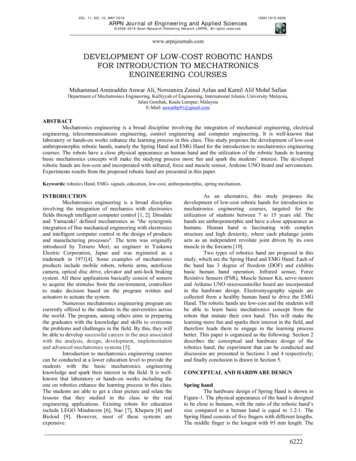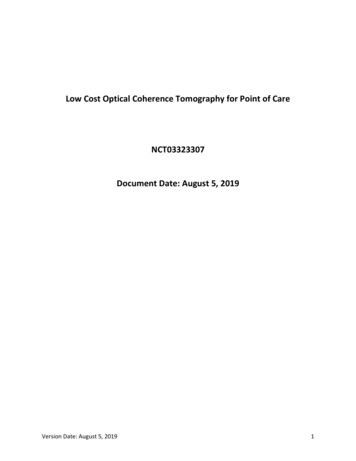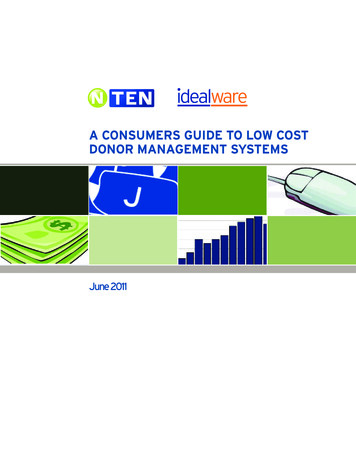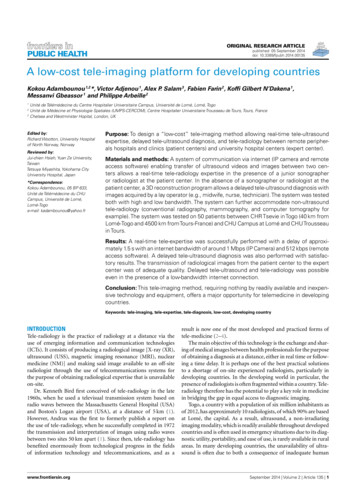
Transcription
ORIGINAL RESEARCH ARTICLEPUBLIC HEALTHpublished: 05 September 2014doi: 10.3389/fpubh.2014.00135A low-cost tele-imaging platform for developing countriesKokou Adambounou 1,2 *, Victor Adjenou 1 , Alex P. Salam 3 , Fabien Farin 2 , Koffi Gilbert N’Dakena 1 ,Messanvi Gbeassor 1 and Philippe Arbeille 2123Unité de Télémédecine du Centre Hospitalier Universitaire Campus, Université de Lomé, Lomé, TogoUnité de Médecine et Physiologie Spatiales (UMPS-CERCOM), Centre Hospitalier Universitaire Trousseau de Tours, Tours, FranceChelsea and Westminster Hopital, London, UKEdited by:Richard Wootton, University Hospitalof North Norway, NorwayReviewed by:Jui-chien Hsieh, Yuan Ze University,TaiwanTetsuya Miyashita, Yokohama CityUniversity Hospital, Japan*Correspondence:Kokou Adambounou, 05 BP 633,Unité de Télémédecine du CHUCampus, Université de Lomé,Lomé-Togoe-mail: kadambounou@yahoo.frPurpose: To design a “low-cost” tele-imaging method allowing real-time tele-ultrasoundexpertise, delayed tele-ultrasound diagnosis, and tele-radiology between remote peripherals hospitals and clinics (patient centers) and university hospital centers (expert center).Materials and methods: A system of communication via internet (IP camera and remoteaccess software) enabling transfer of ultrasound videos and images between two centers allows a real-time tele-radiology expertise in the presence of a junior sonographeror radiologist at the patient center. In the absence of a sonographer or radiologist at thepatient center, a 3D reconstruction program allows a delayed tele-ultrasound diagnosis withimages acquired by a lay operator (e.g., midwife, nurse, technician).The system was testedboth with high and low bandwidth. The system can further accommodate non-ultrasoundtele-radiology (conventional radiography, mammography, and computer tomography forexample). The system was tested on 50 patients between CHR Tsevie in Togo (40 km fromLomé-Togo and 4500 km fromTours-France) and CHU Campus at Lomé and CHUTrousseauin Tours.Results: A real-time tele-expertise was successfully performed with a delay of approximately 1.5 s with an internet bandwidth of around 1 Mbps (IP Camera) and 512 kbps (remoteaccess software). A delayed tele-ultrasound diagnosis was also performed with satisfactory results. The transmission of radiological images from the patient center to the expertcenter was of adequate quality. Delayed tele-ultrasound and tele-radiology was possibleeven in the presence of a low-bandwidth internet connection.Conclusion: This tele-imaging method, requiring nothing by readily available and inexpensive technology and equipment, offers a major opportunity for telemedicine in developingcountries.Keywords: tele-imaging, tele-expertise, tele-diagnosis, low-cost, developing countryINTRODUCTIONTele-radiology is the practice of radiology at a distance via theuse of emerging information and communication technologies(ICTs). It consists of producing a radiological image [X-ray (XR),ultrasound (USS), magnetic imaging resonance (MRI), nuclearmedicine (NM)] and making said image available to an off-siteradiologist through the use of telecommunications systems forthe purpose of obtaining radiological expertise that is unavailableon-site.Dr. Kenneth Bird first conceived of tele-radiology in the late1960s, when he used a televisual transmission system based onradio waves between the Massachusetts General Hospital (USA)and Boston’s Logan airport (USA), at a distance of 5 km (1).However, Andrus was the first to formerly publish a report onthe use of tele-radiology, when he successfully completed in 1972the transmission and interpretation of images using radio wavesbetween two sites 50 km apart (1). Since then, tele-radiology hasbenefited enormously from technological progress in the fieldsof information technology and telecommunications, and as awww.frontiersin.orgresult is now one of the most developed and practiced forms oftele-medicine (2–4).The main objective of this technology is the exchange and sharing of medical images between health professionals for the purposeof obtaining a diagnosis at a distance, either in real time or following a time delay. It is perhaps one of the best practical solutionsto a shortage of on-site experienced radiologists, particularly indeveloping countries. In the developing world in particular, thepresence of radiologists is often fragmented within a country. Teleradiology therefore has the potential to play a key role in medicinein bridging the gap in equal access to diagnostic imaging.Togo, a country with a population of six million inhabitants asof 2012, has approximately 10 radiologists, of which 90% are basedat Lomé, the capital. As a result, ultrasound, a non-irradiatingimaging modality, which is readily available throughout developedcountries and is often used in emergency situations due to its diagnostic utility, portability, and ease of use, is rarely available in ruralareas. In many developing countries, the unavailability of ultrasound is often due to both a consequence of inadequate humanSeptember 2014 Volume 2 Article 135 1
Adambounou et al.resources (i.e., sufficient radiologists or sonographers), as well asa lack of equipment due to, historically at least, the high costsinvolved in purchasing and maintaining the equipment. Recently,however, ultrasound equipment has become more affordable withthe advent of low-cost Asian manufacturers (5). However, evenif a radiologist or sonographer is present and available on-site,they may not be competent in all aspects of ultrasound technique.For these reasons, patients who present to rural and remote clinics with medical conditions that require radiological investigation,are often transferred to urban centers, even when their medicalcondition would be best managed on-site. This is often a massiveburden on patients who have financial limitations and are unableto cover the costs of transport and social care.Access to high bandwidth internet connection and the high costof tele-radiology technology and equipment has historically represented a barrier to the use and spread of tele-radiology in developing countries, where the need is often greatest. The purpose of thisstudy therefore was to develop an integrated tele-ultrasound, teleradiology, and tele-information method for use between expertsat a tertiary medical center (CHU) and remote medical facilities (peripheral hospitals and rural clinics), of minimal cost andpossible with relatively low-bandwidth internet connections, thatwould allow its implementation in low-income countries such asour own.MATERIALS AND METHODSEQUIPMENT AND TECHNOLOGY FOR DATA TRANSMISSION IN THEPRESENCE OF HIGH BANDWIDTH: AXIS 207W NETWORK CAMERA ANDAXIS 243SA VIDEO SERVERA network camera (Axis 207W – address IP) is installed in theremote center (patient center) and the expert center. These twocameras allow for both audio and video transmission betweencomputers at the patient center and the expert center via an internet connection. This therefore enables videoconferencing betweenthe two centers. An internet video server (Axis 243SA – address IP)is connected to an ultrasound machine (any commercial machine)at the patient center and allows for the real-time transmission ofultrasound video sequences via the internet to the computer atthe expert center. The Axis 207W network camera et Axis 243SAvideo server benefit from a full package of security functions,including multiple user access levels with password protection,HTTPS encryption, IP address filtering, thus ensuring secure videohandling and configuration.EQUIPMENT AND TECHNOLOGY FOR DATA TRANSMISSION IN THEPRESENCE OF LOW BANDWIDTH: LogMeIn SOFTWARELogMeIn is a remote access software. It enables one to connect toa host computer from another computer or device (client) at anytime, as long as an internet connection is available. Two LogMeInproducts exist: LogMeIn Free and LogMeIn Pro. LogMeIn Free isfree online and LogMeIn Pro requires a subscription. Followinginstallation of the LogMeIn Pro software on the host computer, itis possible to access the software from any internet enabled computer or mobile device (LogMeIn for iOS or LogMeIn Ignition forAndroid).LogMeIn Pro has a multitude of functions, including transmission of high definition quality video, audio transmission, fileFrontiers in Public Health Public Health Education and PromotionA low-cost tele-imaging platformtransfer, file and desktop sharing, control of multiple monitors,password saving, alerts with LogMeIn central, remote awakeningfrom standby, and system diagnostics.The computers from which one is running and remotelyaccessing LogMeIn must meet the following system requirement:Host system requirement Windows 7, Vista, XP, Server 2003, 2008 (64 bits) Windows ME and 2000 (32 bits) Mac OS 10.4 (Tiger), 10.5 (Leopard), 10.6 (Snow Leopard), and10.7 (Lion) on Mac computers equipped either with a Power PCor Intel processor.Client system requirements Internet Explorer (IE) 6 or a later version (128 or 256 bits). IE7or later is recommended. Firefox 3.6 or later. Google Chrome 2.0 or later. Safari 4.1 or later (Mac only). To use a tablet device or smartphone as client, LogMeIn for iOSor LogMeIn Ignition for Android.The LogMeIn software, by allowing a radiologist at the expertcenter to take control of the computer at the patient center, vialaptop for example, renders possible not only still image transfer (XR, USS, CT, MRI, NM), but also tele-ultrasound expertisein the presence of an inexperienced sonographer or untraineduser at the patient center. In the absence of a sonographer at thepatient center, an expert is able to make a radiological diagnosis in delayed time from ultrasound video sequences sent by anuntrained user, with the use of the 3D virtual navigation program ECHO-CNES (Unité de Médecine et Physiologie Spatialesde Tours) (6). For tele-ultrasound, the computer at the patient center (isolated site) is beforehand connected to the ultrasound devicevia a video converter/USB (Pinnacle for example). Almost all theultrasound devices have a port (bearing) for video converters.LogMeIn includes a security system not only based on a 256bit SSL/TLS encryption, but also multiple authentication systems.In effect, LogMeIn has many systems of authentication, including authentication of the gateway to the Client, authentication ofusers to the gateway, authentication of the gateway to the host, andauthentication of the host to the gateway, ensuring the security ofthe computer data at both the patient and expert center.Finally, LogMeIn can be coupled with Skype to enable audioand face-to-face communication between the operators at the twocenters. Skype is a free software available online that includes a callnotification system and contacts lists.PILOT EXPERIMENT FOR THE TELE-RADIOLOGY PLATFORMFor this pilot study, the remote patient center was CHR Tsévié situated 35 km from Lomé, capital of Togo. CHR Tsévié has a generalmedicine service, an internal medicine service, and a radiologyservice that includes a 2D ultrasound machine (GE Logiq 200) butno on-site radiologist. The expert centers were CHU at Lomé andCHU Trousseau de Tours in France (approximately 4500 km fromTsévié). An internet connection was installed at CHR Tsévie (fiberoptic) and at CHU Lomé (ADSL) for the study. The transmissionSeptember 2014 Volume 2 Article 135 2
Adambounou et al.speed of the internet connection had been measured by online freesoftware such as Speed Test. The approximate averages of the framerate and delay transmission of the ultrasound video sequencesdetermined when the actual speed measured is very close to thattheoretical claimed by the Internet Service Provider were considered. The CHU at Lomé is the second biggest tertiary referralcenter in Togo. The system was tested with 50 patients at CHRTsévie. Patients gave full informed consent. These patients wereeither recruited upon emergency admission to hospital or werealready hospitalized at CHR Tsévie. Diagnostic imaging requestswere ordered initially by the doctors at CHR Tsévie or followinga telemedicine consultation. The experts were university hospitalradiologists. The imaging requests were ordered predominantly bygeneral medicine doctors at CHR Tsévie.The quality of the images tele-transmitted were appreciatedby three expert radiologists (University hospital radiologist), theappreciation retained for the quality of the transmitted imagesfor every bandwidth was that of at least two of the three expertradiologists.RESULTSA bandwidth of a minimum of 1 Mbps was necessary for thetransmission of real-time ultrasound video sequences, but alsobackground video from the remote center with the Axis technology. The quality of the ultrasound images tele-transmitted bythe video server Axis 243SA was sufficient (minimum frame rateabout 10 fps) for an accurate diagnosis with a transmission delay ofA low-cost tele-imaging platformapproximately 1.5 s. The optimal quality of transmission (approximate average frame rate of 35 fps) was obtained with a bandwidthof 4 Mbps, which transmission delay was about 0.5 s.With an average bandwidth of 512 kbps, LogMeIn allowed us totransmit images and video sequences of satisfactory quality with adelay of 2 s. With a bandwidth of 256 kbps, we noticed with LogMeIn a distortion of color ultrasound video sequences, althoughstatic images were of acceptable quality. LogMeIn was also testedwith 3G dongle internet connections (SFR, Helim de TogoTelecom). Video sequences and static images were of satisfactoryquality using this.The LogMeIn file transfer function permitted the direct transferof video files saved at the patient center computer to the computer at the expert site, enabling delayed post-treatment with theECHO-CNES navigation program. A file of 100 Mb in size tookabout 3 min to transfer.The use of Axis technology with an average internet connectionof 2 Mbps enabled the experts at the CHU campus and the CHUTrousseau de Tours en France to perform highly satisfactory realtime tele-ultrasound consultations for 28 ultrasounds: abdominal(n 10), pelvic (n 6), obstetric (n 4), prostate (n 4), andbreast (n 4) (Figure 1). The coupling of LogMeIn with Skypewith a bandwidth of 512 kbps allowed for both tele-ultrasoundand videoconferencing capabilities in 15 cases (Figure 2). Forthese tele-ultrasound videoconferences, the ultrasound operatorat the CHR Tsévie was either a radiology intern sent to the CHUspecifically for the case or the gynecologist at CHR Tsévie. WeFIGURE 1 Screen capture at the expert center during mammary ultrasound with Axis technology.www.frontiersin.orgSeptember 2014 Volume 2 Article 135 3
Adambounou et al.A low-cost tele-imaging platformFIGURE 2 Screen capture at the expert center during an abdominal ultrasound with LogMeIn.were also able to perform seven cases of tele-radiology using LogMeIn relating to conventional XR, computer tomography, andmammograms (Figure 3).With inexperienced ultrasound operators at CHR Tsévie (e.g.,radio operators, nurses, midwives), 10 delayed-time diagnostictele-ultrasound cases were performed with the virtual navigationprogram ECHO-CNES. These tele-ultrasound sessions enableda degree of gradual training at a distance of non-experts (e.g.,midwives).DISCUSSIONThe Axis 207W camera server and the Axis 243SA video internetserver are readily commercially available. The Axis 207W cameraserver was originally designed and intended for indoor video surveillance and to be able to be controlled remotely. The Axis 243SAvideo internet server is used in any facility where an analog surveillance system is already installed but the passage in the digitaltechnology is imperative. This is the first time Axis video internetservers and technology have been used in medical tele-radiologyand represents an innovative use.The Axis 243 video server costs only 850 euros and the Axis 207video camera costs only 350 euros. 1500 Euros is therefore enoughusing this technology to implement a tele-radiology platformbetween a remote center and a center of expertise. The monthlycost of internet connection in Togo actually for 512 kbps is about46 euros, for 1 Mbps is 89 euros, and for 2 Mbps is 172 euros.These costs, which to date are one of the most expensive in WestAfricans countries, will certainly be reduced in the next comingFrontiers in Public Health Public Health Education and Promotionyears in the wake of the new policy of telecommunication committed by the government. We have previously used Axis technologyin conjunction with a cloud based file hosting service (Dropbox)as a low-cost platform for obstetric and gynecological tele-imaging(7). The preliminary technical and clinical results have also beenpublished (8).The Axis technological infrastructure requires a minimumbandwidth of 1 Mbps for a transmission of acceptable quality.While this level of bandwidth is relatively small when compared with the real-time cardiological tele-consultation and teleechocardiography platform proposed by Boman, which requires abandwidth of 20 Mbps (9), such a bandwidth will not necessarilybe available in rural zones in developing countries (10). One of ouraims therefore was to conceive of a system based around the LogMeIn software, which is not only affordable, but also functional inareas with low-bandwidth internet, such as developing countrieslike Togo.LogMeIn is available online and the basic version is free. Thepro-version costs only 53 euros per year per computer. Other thanthe low cost, the high level of security available with LogMeIncompared with many other remote access programs was anotherfactor that attracted us to this piece of software. LogMeIn has twointrusion detection capabilities: SSL/TLS et the LogMeIn intrusion filters. The first level of intrusion detection is based aroundSSL/TLS in order to detect the possible modification of data intransit. The second layer of security relies on three intrusionfilters, namely an IP address filter, a denial of service filter, andan authentication filter.September 2014 Volume 2 Article 135 4
Adambounou et al.A low-cost tele-imaging platformFIGURE 3 Tele-radiology screen capture (vertebral CT scan interpreted remotely using LogMeIn).The file transfer capability available with the LogMeIn Proversion, which allowed transfer of ultrasound files up to 100 Mb inaround 3 min, demonstrates clearly that this software can be usedfor delayed tele-ultrasound diagnosis with ECHO-CNES in thepresence of a non-expert at the patient center.The LogMeIn technological infrastructure, which functionedperfectly well with 3G dongles and modest bandwidth offers therefore a practical mechanism for medical tele-imaging services evenin the most remote areas in which information and communications technologies are lacking. Further, tele-ultrasound expertisecould be made available for patients in ambulances with the use ofthe LogMeIn software. All that is required is a portable ultrasoundon board the ambulance and a 3G dongle for internet connection.One can also envisage the expert being able to view the images ona tablet device or smartphone with the use of LogMeIn for iOS orLogMeIn for android.With untrained ultrasound operators at CHR Tsévié, onlydelayed tele-ultrasound diagnosis with the virtual navigation program ECHO-CNES was possible. This 3D reconstruction program, of which the diagnostic accuracy for general abdomenultrasound was estimated at 91% in a previous study (6), enablesthe expert to review the images sent by the untrained person ata later time and make a radiological diagnosis. Ultrasonographyinvolves a degree of technical skill and precision, and thus it is quiteoperator dependent. As a result, it can be difficult to guide a layperson remotely by voice and/or video. The difficulty in realizingwww.frontiersin.orgreal-time tele-ultrasound with an untrained operator has led someauthors to produce visual guides
LogMeIn is a remote access software. It enables one to connect to a host computer from another computer or device (client) at any time, as long as an internet connection is available. Two LogMeIn products exist: LogMeIn Free and LogMeIn Pro. LogMeIn Free is free online and
